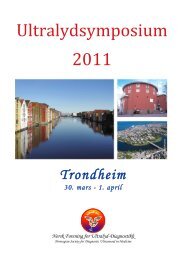Ultralydsymposium - NORSK FORENING FOR ULTRALYD ...
Ultralydsymposium - NORSK FORENING FOR ULTRALYD ...
Ultralydsymposium - NORSK FORENING FOR ULTRALYD ...
- No tags were found...
You also want an ePaper? Increase the reach of your titles
YUMPU automatically turns print PDFs into web optimized ePapers that Google loves.
Interpretation of GI wall layers in health and diseaseSvein Ødegaard, National Centre for Ultrasound in Gastroenterology, Department ofMedicine, Haukeland University Hospital and Institute of Medicine, University of Bergen,Bergen, NorwayThe components of the wall of the gastrointestinal (GI) tract can be imaged usingendoscopic ultrasonography (EUS) and transabdominal ultrasound (US).The five layers seen on US images of the GI wall (seen from the mucosal side)correspond to the following: interface echo between the superficial mucosa and theacoustic coupling medium (typically water), deep mucosa, submucosa plus the acousticinterface between the submucosa and muscularis propria, muscularis propria minus theacoustic interface between the submucosa and muscularis propria, and serosa andsubserosal fat. If a high-frequency (>15 MHz) transducer is used, nine layers canpotentially be identified. These nine layers correspond to the following: epithelialinterface, epithelium, lamina propria plus the acoustic interface between the lamina propriaand the muscularis mucosae, muscularis mucosae minus the acoustic interface between thelamina propria and muscularis mucosae, submucosa plus the acoustic interface between thesubmucosa and inner muscularis propria, inner muscularis propria minus interface betweenthe submucosa and inner muscular propria, fibrous tissue band separating the inner andouter muscularis propria layers, outer muscularis propria, and serosa and subserosal fat.It is important to understand that echoes originate from interfaces between twostructures with different impedances (e.g., between mucosa and submucosa). Although theinterface between two tissue structures has no thickness, interface echoes will be at leastthe same thickness as the spatial pulse length (SPL). The interface echo also appears to bethicker for irregular surfaces such as the gastric and colonic columnar epithelium with itsassociated pits and crypts. The finite thickness of the interface echoes can affect theapparent thickness of a structure on US imaging. The rationale for this is if the structurebeyond the interface is less echogenic than the structure superficial to the interface, thesuperficial layered structure will appear thicker than it actually is. If the structure beyondthe interface is less echogenic than the structure superficial to the interface, and thestructure beyond the interface is thinner than the SPL, then the structure beyond theinterface will be obscured by the echo from the interface. If the structure beyond theinterface is more echogenic than the interface, then the interface echo will blend with theechoes from the layer itself and the thickness of the structures will not change.Variations in the Wall StructureThe GI tract wall maintains essentially the same layered structure from the esophagus tothe rectum with some regional differences. These regional differences will briefly bereviewed.EsophagusThe first echogenic layer in the esophagus is typically thin since the squamous epitheliallining is smooth as opposed to the rougher columnar epithelium seen in the rest of the GItract. The mucosal and submucosal layers are quite thin in the esophagus and are difficultto resolve without using a high frequency probe and imaging through water in the lumen.The muscularis propria layer is often separated into three layers consisting of the innercircular muscle layer, an intermuscular connective tissue layer, and the outer longitudinalmuscle layer. Since the esophagus does not have a serosal layer, the fifth echogenic layer isusually comprised of the adventitia and surrounding fat.











